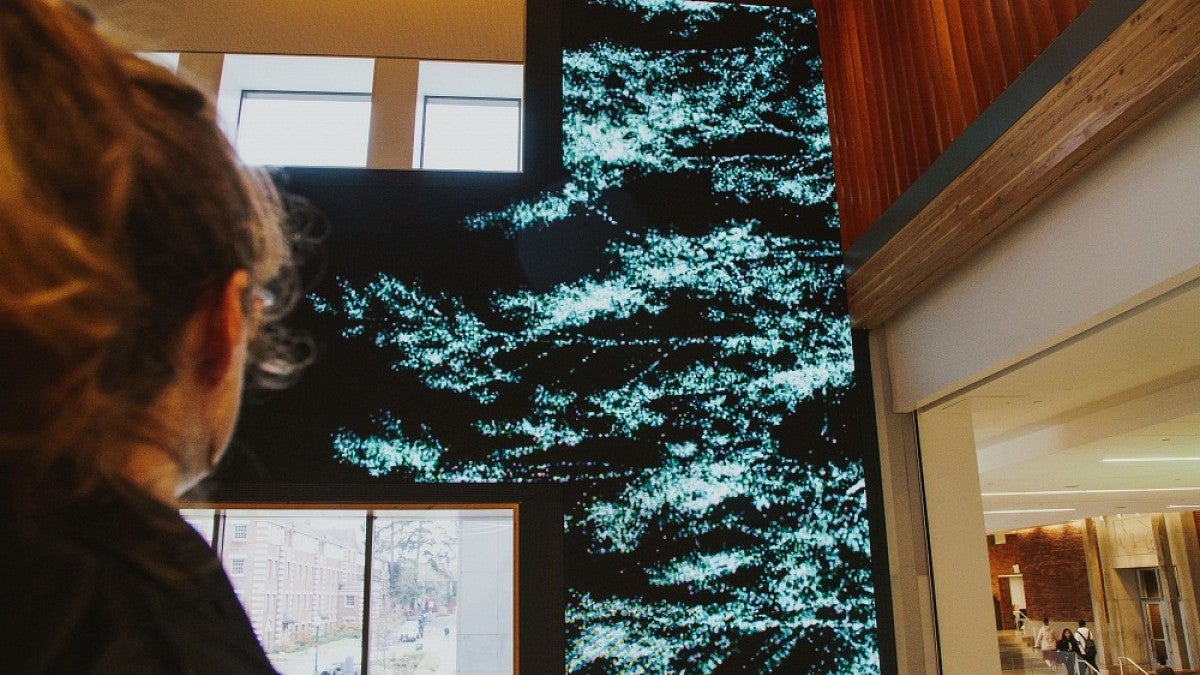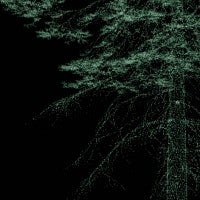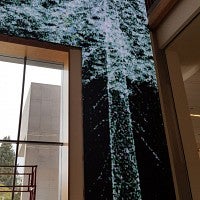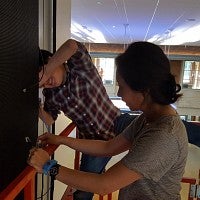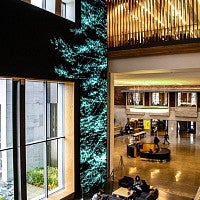The mighty Douglas fir can grow upwards of 300 feet and live beyond a thousand years, but thanks to a new permanent video art installation in the Erb Memorial Union, you can watch the tree’s lifecycle, from sapling to ancient giant, in a 24-hour period.
Come midnight, the giant falls to the ground and begins anew.
“It’s one of the great natural resources,” said artist and architect Annie Han of the Douglas fir. “I wanted to make an artwork about that — how lucky we are to have this beautiful thing around us all the time.”
Han and partner Daniel Mihalyo, with their Seattle art and architecture firm Lead Pencil Studio, created the commission “Sunrise Sunset,” a 50-foot-tall LED video installation, using lidar technology, for the recently renovated Erb Memorial Union lobby. The installation explores ways that art, architecture, technology and design can come together to push innovation.
The project was prompted by the Oregon Arts Commission’s Percent for Art program, which states that 1 percent of construction funds for new or remodeled state buildings are designated for art acquisition.
In 2016, Oregon Arts Commission Public Art Project Manager Rebecca Banyas put together the EMU Artist Selection Committee, which included professor of art Carla Bengston, EMU assistant director of retail services Dan Geiger, EMU associate director Jessi Steward, UO Campus Design and Construction owner representative Martina Oxoby, Eric Phillips of SERA Architects, campus planning associate Eleni Tsivitzi, and then-College of Design student Tracie Jackson. The committee put out a call for proposals.
Banyas said the committee chose Lead Pencil Studio because the duo’s proposal was “innovative, captivating and had a strong base in Oregon with the Douglas fir tree.” The fact that they were alumni was a plus.
Han, a 1993 architecture graduate, and Mihalyo, who earned the same degree in 1994, met as undergraduates at the UO College of Design and started their design firm soon after. Lead Pencil Studio is no stranger to massive public art installations: In 2019 alone, the firm completed the 100-foot-tall “Transforest” in Seattle and the 30-foot-wide “Oblique Intersection” at Texas Tech University.
As finalists for this commission, they returned to campus.
“When we went down to do a site visit, walking around Eugene, we were struck by how enormous the trees have grown in the 25 years we’ve been away since graduation,” Mihalyo said.
The shape of a Douglas fir, the duo pointed out, would also fit the tall, narrow dimensions of the space, while retaining a beautiful form when viewed from different levels or angles.
Han, who spent long hours studying in the EMU as a student, says the piece also represents the students’ own growth cycles as they go through school.
“You go there and you’re in a book for a while. You look up. A chunk of time has passed. I wanted the wall to express that,” Han explained. “You could look up and it would inspire you once in awhile.”
“We didn’t want it to be fast moving or flickering,” Mihalyo added. “Our intent was for it to be a meditative ambient piece. You could zone out and go into that deep space for a minute and then go back to your studies.”
To capture the Douglas fir life span, they used the 3D-scanning software lidar. Over the course of a few summers, Han and Mihalyo traveled throughout the Willamette Valley, the Cascade Range and the Coast Range to capture the species at different stages. They took that data and animated it, adding in a few little Easter eggs along the way — a raven here, a snowfall there.
Due to the large scale of the LED screens, the team decided to keep the video somewhat grainy and abstract, partly to differentiate from the beautiful live trees that can be seen through many an EMU window and partly to reduce eyestrain.
“So, it’s not tiring to your visual field,” Mihalyo said.
Han and Mihalyo also wanted to emphasize the time-based aspect of the work, so students could synchronize their routines to it, whether that is watching the snow fall during a study group or meeting a roommate to walk home when the fir returns to the earth.
“A successful public artwork takes those things into consideration. It’s site specific,” Han said. “We wanted to be thoughtful and make art that is very sensitive and harmonious with the kind of activity happening around the space.”
—By Alex Cipolle, College of Design


